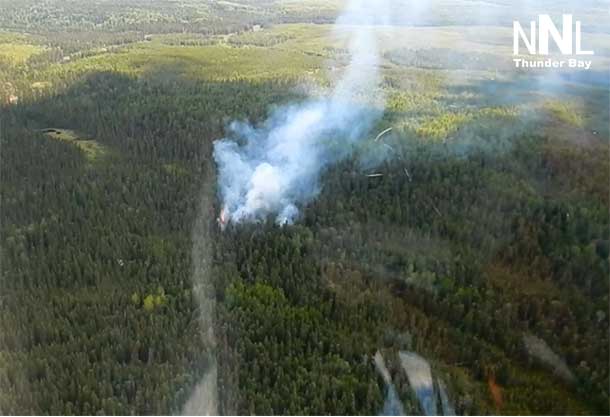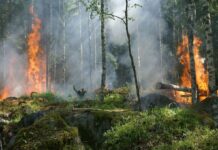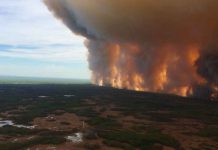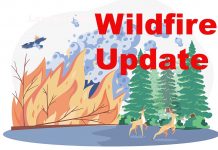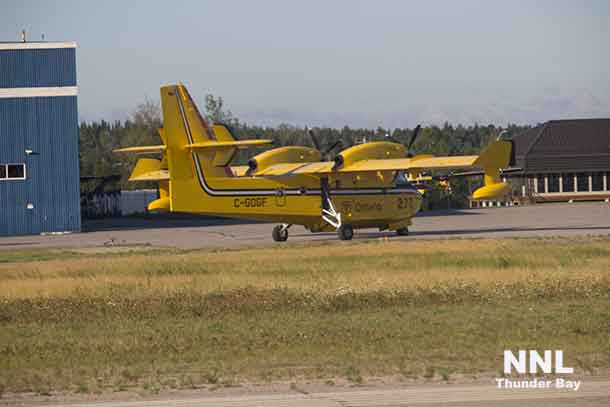
by Jamie Scrimger
Five New Wildfires Reported
THUNDER BAY – WILDFIRE – Smoke drift is forecast to be detectable throughout the far north due to large fires in the Northwest Territories, Northern Saskatchewan and Manitoba. Communities in relative proximity to monitored fires in Ontario may detect smoke but concentrations are forecast to be light.
The Northwest region is getting multiple new fire starts daily. Suppression activities continue with good progress being made and many of the remote fires are being monitored as they burn to natural boundaries like rivers and lakes. FireRangers are a mobile firefighting force and move between districts and regions to provide support to the areas with the most fire activity and highest fire risk.
The fire hazard across the region is high. To track the fire hazards and to see a complete list of fires across the province click on our interactive map. You can also get the latest update on the condition of any fire by clicking the fire icons.
There were 5 confirmed fires by the afternoon of August 6. 2 in the district of Kenora, one each in Red Lake, Fort Frances and Sioux Lookout and another fire is currently being investigated in Thunder Bay.
There were 15 confirmed fires by day’s end on August 6. The Dryden and Nipigon districts had one fire each, 2 were in Kenora, 4 were in Red Lake and 7 were in the Sioux Lookout district.
The majority of the new fires are caused by lightning.
Out of Province Deployment
- Currently there are over 220 staff supporting the province of British Columbia in their fire management efforts.
- Ontario, as part of the Great Lakes Forest Fire Compact (GLFFC) including Michigan, Minnesota and Wisconsin has formed international crews of firefighters currently deployed to British Columbia.
- Ontario is maintaining a significant number of firefighting staff on the ground in British Columbia to help support ongoing firefighting efforts. This is being done while also ensuring we have the necessary firefighting personnel here at home and are responding to the new and ongoing forest fire activity in Northwest Ontario.
The public is urged to take an active role in preventing more fires. This can be done by not burning when it is windy, monitoring your fire and ensuring that you have water nearby to extinguish your fire. As a reminder, there is no day burning of brush and grass.
Planning to have a campfire?
Here are some tips on how to safely enjoy your campfire and avoid the costs and dangers that can arise from an unextinguished or unattended campfire:
- Choose your site carefully. Select a site with easy access to water that is sheltered from high winds. The fire must be built on bare rock or non-combustible material.
- Prepare the site. Clear a one metre space around your campfire site and remove all pine needles, grasses, leaves and twigs.
- Keep your fire small. By law, your campfire cannot exceed one metre in height and one metre in diameter.
- Stay nearby. Never leave your campfire unattended.
- Put your fire out. Soak your fire with water.
- Be sure the fire is extinguished. Stir the ashes with a stick to uncover hot coals and then soak it again!
Ontario has increased the maximum fines for individuals and corporations for starting forest fires.
Increased Fines for Starting a Forest Fire
‘Ontario Strengthens Law to Deter Forest Fires’
Fire numbers and online information:
- Forest Fire Reporting Number – 310-FIRE (3473)
- Follow us on Twitter: in English @ONForestFires or in French @ONFeuDeForêt
- For guidelines on safe outdoor fire management ontario.ca/fireprevention

